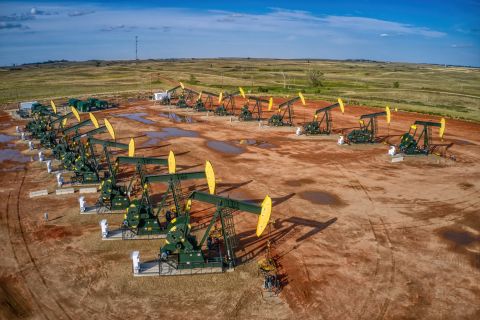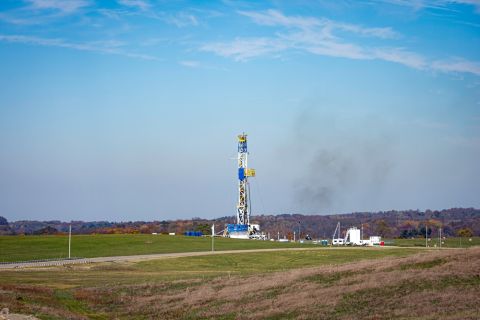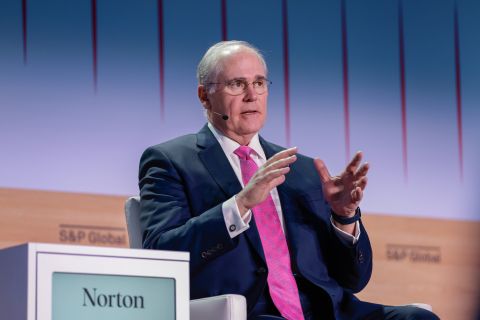There's been a lot of talk this week about the importance of U.S. natural gas in reducing GHG emissions and providing energy security to buyers in Europe and Asia, so we are lucky to be talking with EQT, one of the largest producers of natural gas in North America. I'm Chris Matthews, senior editor of shale and A&D at Hart Energy, and this is your Hart Energy Live exclusive interview with Toby Rice, CEO of EQT.
Chris Mathews, senior editor of shale and A&D, Hart Energy: My first question is just, can you give us your outlook on where you think pricing is going to go?
Toby Rice, president and CEO, EQT Corp.: Yeah, certainly. The volatility we experienced in '22, I think it's a different world. Simply put, what happened in '23—weather did not show up. That lack of weather destroyed about 500 Bcf of demand. When we think about that on a Bcf per day, it was about 12 Bcf a day of demand that we lost, 10 Bcf a day that came from lack of weather and the other two Bcf a day came from Freeport LNG being offline.
Well, Freeport LNG is back online, and we think that the low prices that we're seeing right now will cause operators to respond in lower activity levels. We're already seeing that. So allies are focused on those activity reductions, and that should lead to a more balanced gas market in the second half of this year. You know, long term, ‘22 really just made us even more bullish… on natural gas long-term. When we think about pricing, we think about long term. “What is the cost of supply going to be?” We believe we can put natural gas on the doorstep of Europe for cost of $12, and that would apply a $4 gas price here in the United States. You know, that's a really amazing situation, not only for industry, but for society in general. Europeans would be thrilled to be getting their energy prices at $12. You know, they were paying north of $80 in ’22. $12 energy for Europeans, they'd be doing back flips. We'd be really happy to do that for them. And $4 gas price here in the United States, Americans would be ecstatic. It's lower than the 20-year average price of $4.50.
And at that price structure, our industry, the people that will be building—drilling the wells, building the pipelines and the LNG facilities—will be able to make modest returns. And we think that's a sustainable, profitable solution that's going to be value-creating for society. Now, for us to be able to make that happen and get to that price structure, we need to ensure that we have a free market and that the low cost supply can move to the demand. But unfortunately, to make that happen, we need to have more pipelines and more LNG facilities built. And the key to making that happen is going to be more permit reform to ensure that the market dynamics can take place, and so we can have a free market with better permit reform.
CM: I think I've heard some cautious optimism around these halls so far this week, but curious what you think is going to happen on permitting reform.
TR: Permit reform is inevitable. You know, one thing that's clear is the world's demand for energy is not going to decrease. And why is that is because energy is the key to human progress. Full stop. People need energy to improve their quality of lives. We've seen how critical that is, and we've seen the critical impacts—if countries do not have their energy security, look at what happened in Europe. People want to avoid that from happening. Energy demand is going to be there. The key is going to be can we build the infrastructure to meet that demand? We're either going to be able to be proactive and take advantage of the current market as we see it right now—demand is going to continue to go up—and be proactive and pass effective legislation that allows us to get this pipeline infrastructure built, or people will realize that this industry and our energy system as a whole is running at max capacity because of our inability to get pipeline infrastructure built and other energy infrastructure built. You look at the EIA came out and said how much pipeline we got built this past year was the lowest level of pipelines, interstate pipelines built since 1995. Now, to put that in perspective, we built 3% of the pipelines that we built compared to 2017, just five years ago. Clearly, it shows the issue, and if we don't correct this right now, we're one unforeseen event away from having a major issue. We saw the issues that happened when Colonial Pipeline went down. You saw the issues what happened when Uri went down. We don't know what it's going to be, but there will be some type of event that we can't predict. We need to be prepared for that and to be prepared for that, we need to build in that excess capacity. The key to that—building more pipelines and energy infrastructure. And the key to that is pipeline reform. So we have an opportunity to recognize the importance and the need to get this done proactively.
CM: You've talked a lot about LNG and unleashing U.S. LNG, of course. Curious if you can give us any insights into whether you're continuing to have discussions with LNG exporters and in terms of supplying gas to those facilities?
TR: Yes, we've certainly been big champions on our energy transition plan for the world—which is transitioning the world from coal to gas. And we're going to do that in the form of ramping production here in the United States, using that production to liquefy this resource and ship it overseas to replace foreign coal, which is the biggest source of emissions on the planet. We have the resource potential in the United States to increase production over 50%. That would be an incremental 50 Bcf a day of energy that we could put on the world stage to replace foreign coal. Every Bcf a day that we could put on the water to replace foreign coal would save over 30 million tons. That's the math. When you add all that up, the emissions reduction potential of unleashing U.S. LNG is equivalent to electrifying every vehicle in the country, putting solar panels on every house and also doubling U.S. wind capacity, combined. It's absolutely massive. That's why we call it the biggest green initiative on the planet.
When we talk about the other benefit, the other thing we learned in ‘22, it's not just about the environment, it's about energy security. And without energy security, you cannot transition. And the key to energy security is American natural gas, specifically U.S. LNG. From an energy security perspective, this has really gotten a lot people really excited—60 Bcf a day of gas on the world stage. People don't really know what that is, but 60 Bcf a day to make that relevant is the energy equivalent of adding 10 million barrels a day of clean energy to the world. That's like the United States… ha[ving] the ability to add Saudi Arabia's worth of energy to the world stage. It's going to be a decarbonizing force and provide a massive energy security blanket to the world. That's the prize that we're playing for—the biggest green initiative on the planet and the biggest energy security blanket for the world and the key to low prices here in America. It's an amazing prize and we've really been excited about moving the ball forward. Right now, some of the steps we can do in the meantime is take advantage of some of the Gulf Coast capacity. We ship about 25% of our volumes to the Gulf Coast. It's about a little bit over a Bcf a day, and now we're working to convert that capacity we have to the Gulf Coast to international exposure by talking to some of the LNG facilities down there.
CM: Oh, I see. What's happening with regards to LNG potential on the East Coast? I know there had been considerations at some point in looking at Penn[sylvania] LNG. I'm curious if you have ever considered taking your own destiny into your own hands, so to speak, and constructing or developing your own LNG export project. Is that something you could see EQT doing in the future?
TR: That’s something that we're looking at. LNG is going to be the tie that lifts all ships in America when it comes to natural gas production. But the prize for EQT really is to unlock sustainable growth and the ability for us to not just be in maintenance mode, but be able to invest in those high rate-of-return drilling projects that are sort of sitting, waiting for sustainable demand to be created. We can create that sustainable demand if we can bring LNG to the East Coast. Now, that is a very long put, and I understand that there's a lot of things that need to take place, but we are exploring it because the prize is so massive. East Coast LNG would be transformative, not only to EQT, but to the United States and the rest of the world.
You know, one of the things that's happened recently that's been constructive is the state of Pennsylvania has passed a law to establish a Philly LNG task force. This group is mandated to go in and explore how we can bring LNG to the East Coast. That would be amazing. And equally as important, I was very encouraged to get a call from the governor a few weeks ago appointing EQT and myself to the Philly LNG task force. So, it's a long put, there's a lot of things that need to line up, but we, EQT and myself, we are in the room and we'll be looking for ways to connect the dots and set the table for a potential East Coast LNG project. It's down the road, but super transformative and we will definitely give it a serious amount of attention.
CM: Thanks so much for taking the time to speak with us.
Learn more about EQT online at hartenergy.com.
Recommended Reading
Beacon Offshore Divests Non-op Gulf of Mexico Interests
2024-04-05 - Beacon Offshore Energy said that with its non-op assets divested, it would turn all of its focus to its Shenandoah and Winterfell assets in the Gulf of Mexico.
Is Grayson Mill the Next Bakken Domino to Fall After Chevron-Hess?
2024-01-31 - As E&Ps look to bulk up outside of the Permian Basin, EnCap-backed Bakken player Grayson Mill Energy is reportedly exploring a sale valued around $5 billion.
Ohio Oil, Appalachia Gas Plays Ripe for Consolidation
2024-04-09 - With buyers “starved” for top-tier natural gas assets, Appalachia could become a dealmaking hotspot in the coming years. Operators, analysts and investors are also closely watching what comes out of the ground in the Ohio Utica oil fairway.
ONEOK CEO: ‘Huge Competitive Advantage’ to Upping Permian NGL Capacity
2024-03-27 - ONEOK is getting deeper into refined products and adding new crude pipelines through an $18.8 billion acquisition of Magellan Midstream. But the Tulsa company aims to capitalize on NGL output growth with expansion projects in the Permian and Rockies.
Marketed: KJ Energy Operated Portfolio in East Texas
2024-04-16 - KJ Energy has retained TenOaks Energy Advisors for the sale of its operated portfolio located in East Texas.



